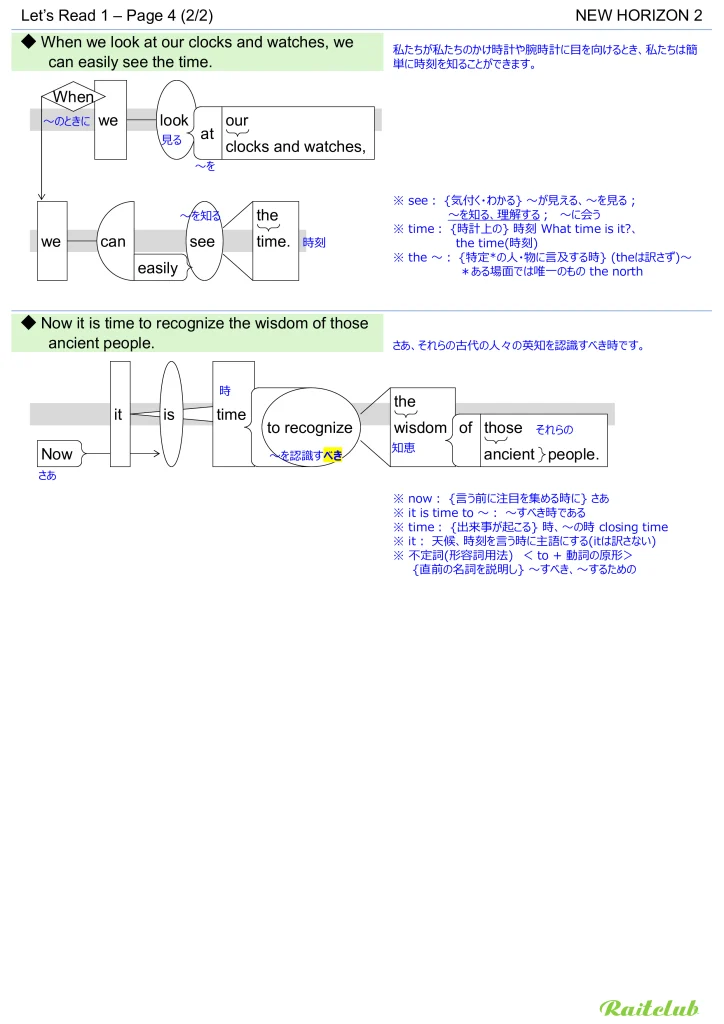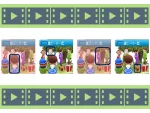中学2年生教科書 New Horizon 2 (ニューホライズン 2年) Let’s Read 1: History of Clocks の重要文法と、本文・和訳・英文見える化チャートです。
英文見える化チャートは、英語の「意味理解」を視覚的にサポートするツールです。習得を促進する音声付きです。音読活動などで活用することで英語を身に着けるのを支援します。
ポイント解説付きなので、定期テスト対策として、単語の意味・用法や、文法・文構造の確認にも使えます。
なおこのページでは英語のみの音声も聞けます。リスニングやシャドウイングなどでお使いいただけます。
重要復習事項
目的語を2つとる動詞
接続詞 when
不定詞(副詞用法・形容詞用法)
本文・和訳・チャート
音声リスト
※ バックグラウンド再生もできます
以下の各パート内の音声は速度調整(75%など)や個別にループ再生もできます
速度を90%などに設定したい場合は以下のYoutube音声をお使いください
Let’s Read 1 – Page 1
◇ History of Clocks
時計の歴史
参考) time:
〇連続: {概念/連続した} 時間 time flies(時間は速く過ぎる)、{使える} 時間 have time(時間がある);
〇一点: {時計上の} 時刻 What time is it?、the time(時刻)、{出来事が起こる} 時、~の時 closing time;
〇期間: {時間の区切り} 期間、間 for a long time、{機会・出来事・経験} 時、回 have a great time , for the first time
◆ When we need to see the time, we look at clocks or watches.
私たちが時刻を知る必要があるときに、私たちはかけ時計や腕時計に目を向けます。
※ see: {気付く・わかる} ~が見える、~を見る; ~を知る、理解する; ~に会う
※ time: {時計上の} 時刻 What time is it?、the time(時刻)
※ the ~: {特定*の人・物に言及する時} (theは訳さず)~
*ある場面では唯一のもの the north
◇ Today we can check the time very easily.
現在では私たちはとても簡単に時刻を調べることができます。
◇ However, it was not so easy long ago.
しかしながら、それはずっと前はそれほど簡単ではありませんでした。
※ however: {それまでの内容とは逆の・異なる内容をいう時} しかしながら
◇ Time keeping has a very interesting history.
時間の計測はとても興味深い歴史を持っています。
※ time: {概念/連続した} 時間 time flies(時間は速く過ぎる)
※ time keeping: 時間の保持 → 時間の計測・管理
◆ Ancient people used nature to read the time.
古代の人々は時刻を読むために自然を利用しました。
◇ About 6,000 years ago, Egyptians used the sun.
約6,000年前、エジプト人たちは太陽を使いました。
※ the ~: {特定*の人・物に言及する時} (theは訳さず)~
*地球周辺では唯一なので特定できる
sun(恒星の意味も) → the sun(太陽)
◆ They put sticks in the ground, and the shadows told them the time.
彼らは地面に棒をたて、その影が彼らに時刻を伝えました。
※ the ground: 地球の表面、地面 *地球周辺で唯一
※ the shadows: (棒による)影 *theで文脈・状況からわかる特定の影に言及
◇ These were some of the first clocks in the world.
これらは世界で最初の時計のうちのいくつかでした。
※ the first clocks: 最初の時計 *theで語句の意味上、唯一となるものに言及
参考)最上級、最後の・n番目の、唯一つのなどでも同様 the best restaurant, the last day, the only way
※ the world: (この)世界 *theで地球周辺で唯一の world に言及
world(生物のいる天体の意味も)
音声(英語/習得用)
| ♪ 英語の音声: | |
| 1回再生 | |
|---|---|
| ループ再生 | |
| ♪ 習得用の音声(英⇒日を区切りごと): | |
| 1回再生 | |
|---|---|
| ループ再生 | |
英文見える化チャート 1/2
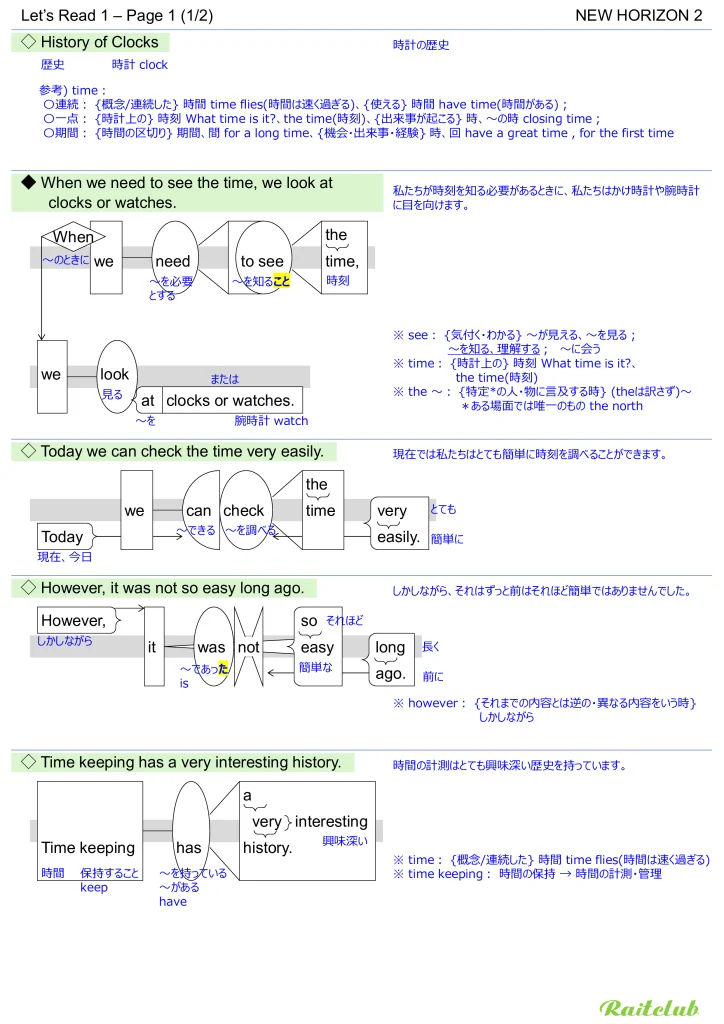
英文見える化チャート 2/2
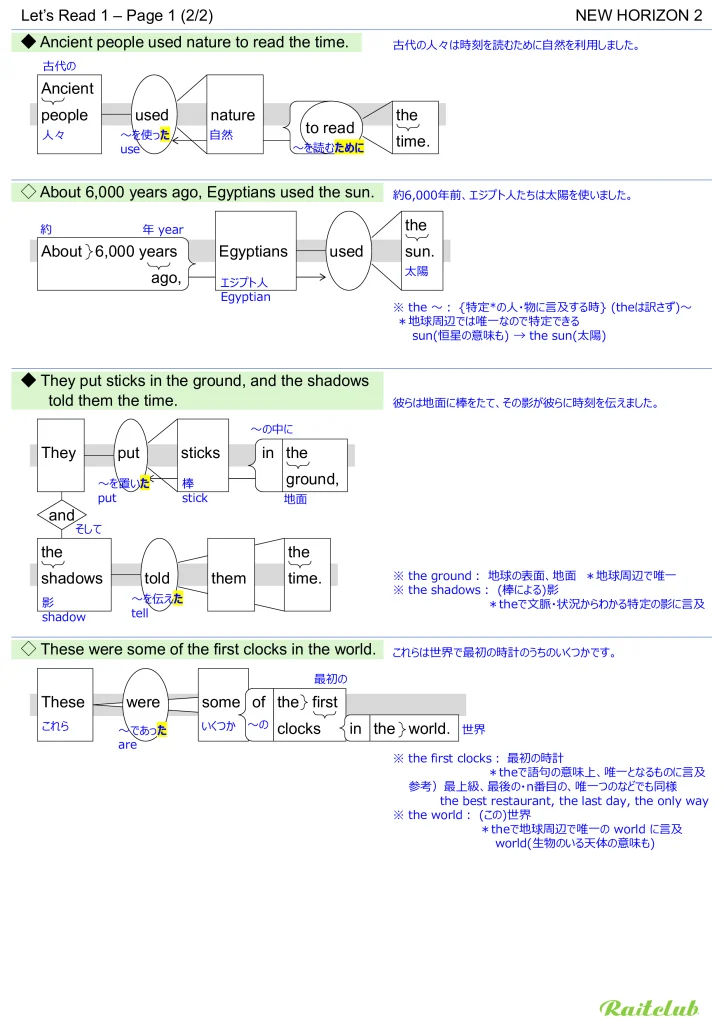
Let’s Read 1 – Page 2
◇ At night, people could not use the sun.
夜においては、人々は太陽を使うことができませんでした。
※ at [ ]: [時刻/時刻名/時の一点] に at 3:00/at noon/at that time ★ 一点
※ in [ ]: [朝/午後など]に in the morning [月/季節/年] に in May/in summer ★ ~の中に
※ at night: 夜に *夜は一点の扱い 但し特定の夜の時間帯に焦点なら in the night
※ could: 助動詞 can の過去形
{過去での能力}~することができた
◇ About 3,500 years ago, Egyptians started to measure time without it.
約3,500年前、エジプト人たちはそれなしで時間をはかることを始めました。
※ time: {概念/連続した} 時間
◇ They put water in pots.
彼らはつぼに水を入れました。
※ put: put の過去形
※ put: {手などを使い特定の場所へ} ~を移動させる、~を置く
◇ The pots had tiny holes in them.
それらのつぼは、その中に小さな穴を持っていました。
※ the pots: (水を入れた)つぼ *theで文脈・状況からわかる特定のつぼに言及
◇ The water decreased little by little.
その水は少しずつ減りました。
※ by [ ]: [変化や差異の大きさ/単位] の差で/ずつ decrease by 2% /by the hour(時間毎) ★ 近接 ~によって
※ little by lettle: 少しずつ one by one(1つずつ)
◆ The lines in the pots told them the time.
それらのつぼの中の線が、彼らに時刻を伝えました。
◇ About 1,500 years ago, other people used fire.
約1,500年前、他の人々は火を使いました。
◇ They burned candles, for example.
例えば、彼らはろうそくを燃やしました。
※ for [ ]: [相当する物] として for lunch ★ 方向 ~のため
※ for example: 例として → 例えば
◆ The candles gave them light, and people saw the time by the lines on them.
それらのろうそくは彼らに光を与え、人々はそれらの表面の線によって時刻を知りました。
※ by [ ]: [手段/方法] によって ★ 近接 ~によって
音声(英語/習得用)
| ♪ 英語の音声: | |
| 1回再生 | |
|---|---|
| ループ再生 | |
| ♪ 習得用の音声(英⇒日を区切りごと): | |
| 1回再生 | |
|---|---|
| ループ再生 | |
英文見える化チャート 1/2
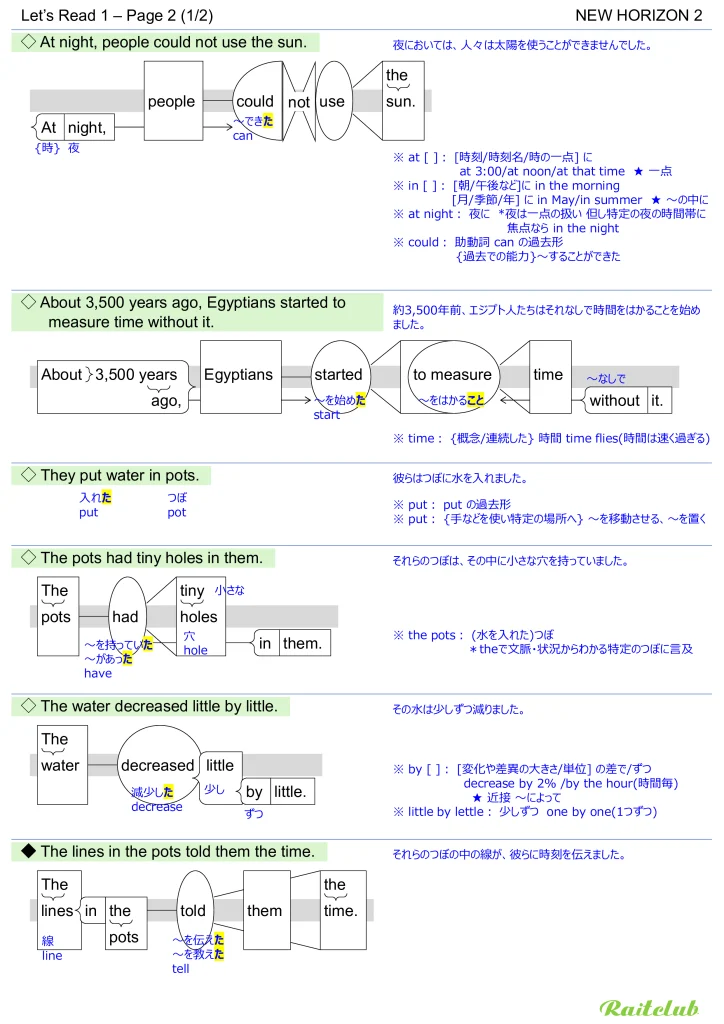
英文見える化チャート 2/2
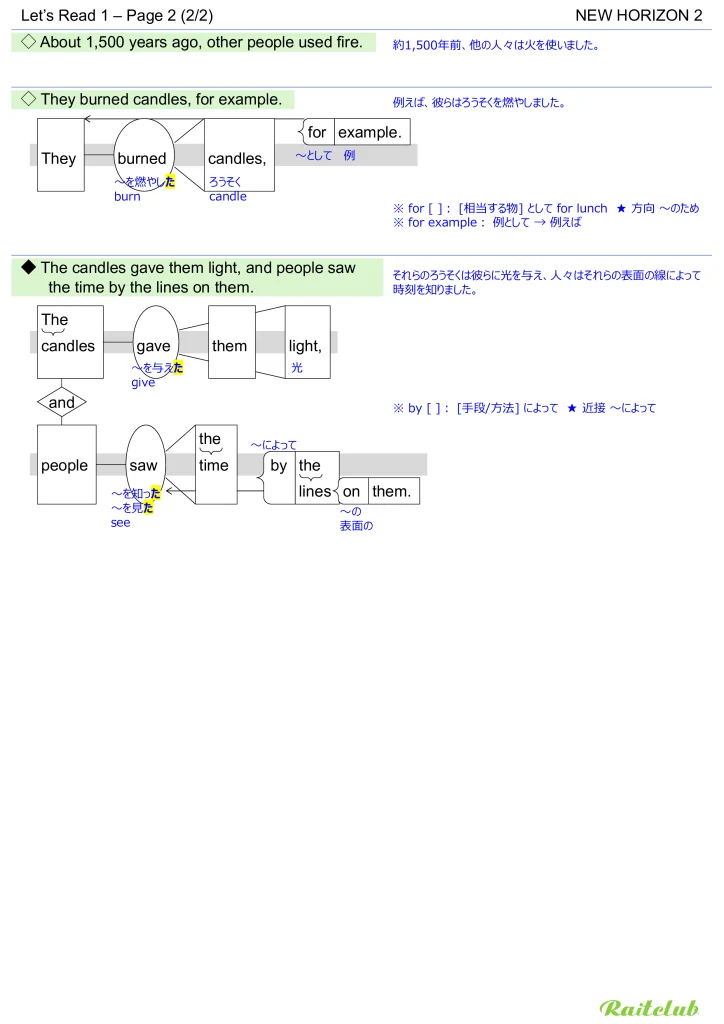
Let’s Read 1 – Page 3
◇ About 700 years ago, people started to make mechanical clocks.
約700年前、人々は機械式時計を作ることを始めました。
◆ At first, they used weights to power these clocks.
最初は、これらの時計に動力を供給するために、彼らはおもりを使いました。
※ 不定詞(副詞用法) < to + 動詞の原形>
{動作の目的} ~するために
◇ The clocks told the hour with bells.
それらの時計はかねで時間を伝えました。
※ the hour: 時刻 *theである場面では唯一のものに言及
参考) the hour で正時(分・秒の端数のないきっかりの時間)を指すことも
※ with [ ]: [道具] で ★ 付帯 ~といっしょに
◆ However, the weights were big and heavy, so these clocks were difficult to move.
しかしながら、それらのおもりは大きくて重かった、だからこれらの時計は動かすのが難しかったのです。
※ 不定詞(副詞用法) < 形容詞 + to + 動詞の原形>
{難易などの対象の動作} ~するには …だ The water is safe to drink.
参考) {感情などの原因} ~して …だ nice to meet you
※ = so it was difficult to move these clocks.
◇ About 500 years ago, people improved their clocks.
約500年前、人々は彼らの時計を改良しました。
◆ They used springs to power the clocks.
彼らはそれらの時計に動力を供給するためにぜんまいを使いました。
◇ The springs were small and light.
それらのぜんまいは小さく軽かったです。
◇ So people could move the clocks easily.
だから人々は簡単にそれらの時計を動かすことができました。
◇ Eventually, people began to carry watches.
最後には、人々は時計を持ち運ぶことを始めました。
音声(英語/習得用)
| ♪ 英語の音声: | |
| 1回再生 | |
|---|---|
| ループ再生 | |
| ♪ 習得用の音声(英⇒日を区切りごと): | |
| 1回再生 | |
|---|---|
| ループ再生 | |
英文見える化チャート 1/2
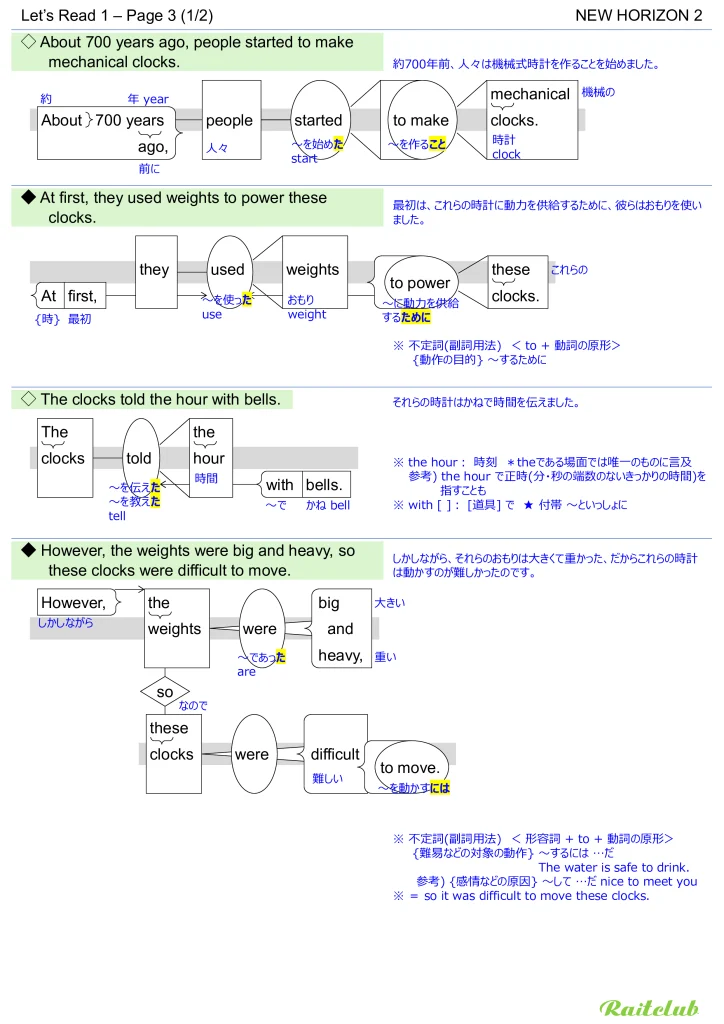
英文見える化チャート 2/2
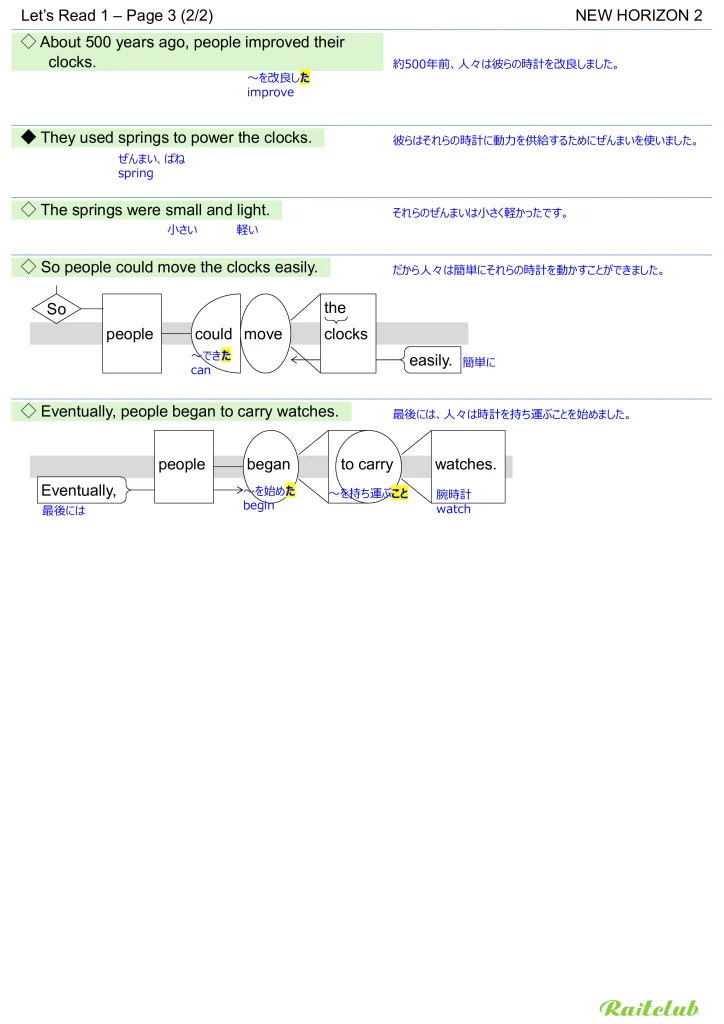
Let’s Read 1 – Page 4
◇ Today, we have clocks and watches everywhere.
現在では、私たちはいたる所にかけ時計や腕時計を持っています。
◇ This is the result of many great inventions and many people’s efforts.
これは多くの偉大な発明と多くの人々の努力の結果です。
※ the ~ + of … など: {~の意味範囲を of … などで限定して使う時} (theは訳さず) … の ~
◇ Even now, clocks and watches are improving.
今でさえ、かけ時計や腕時計は進歩しています。
※ even: {驚くべきことなのを強調して} でさえ
◇ We cannot really see time, but ancient people tried to recognize it.
私たちは実際に時間というものを見ることはできません、しかし古代の人々はそれを認識することを試みました。
※ time: {概念/連続した} 時間 time flies
◆ They used different ideas and technologies to measure it.
彼らはそれをはかるために、異なる(さまざまな)考えや技術を使いました。
◆ When we look at our clocks and watches, we can easily see the time.
私たちが私たちのかけ時計や腕時計に目を向けるとき、私たちは簡単に時刻を知ることができます。
※ see: {気付く・わかる} ~が見える、~を見る; ~を知る、理解する; ~に会う
※ time: {時計上の} 時刻 What time is it?、the time(時刻)
※ the ~: {特定*の人・物に言及する時} (theは訳さず)~
*ある場面では唯一のもの the north
◆ Now it is time to recognize the wisdom of those ancient people.
さあ、それらの古代の人々の英知を認識すべき時です。
※ now: {言う前に注目を集める時に} さあ
※ it is time to ~: ~すべき時である
※ time: {出来事が起こる} 時、~の時 closing time
※ it: 天候、時刻を言う時に主語にする(itは訳さない)
※ 不定詞(形容詞用法) < to + 動詞の原形>
{直前の名詞を説明し} ~すべき、~するための
音声(英語/習得用)
| ♪ 英語の音声: | |
| 1回再生 | |
|---|---|
| ループ再生 | |
| ♪ 習得用の音声(英⇒日を区切りごと): | |
| 1回再生 | |
|---|---|
| ループ再生 | |
英文見える化チャート 1/2
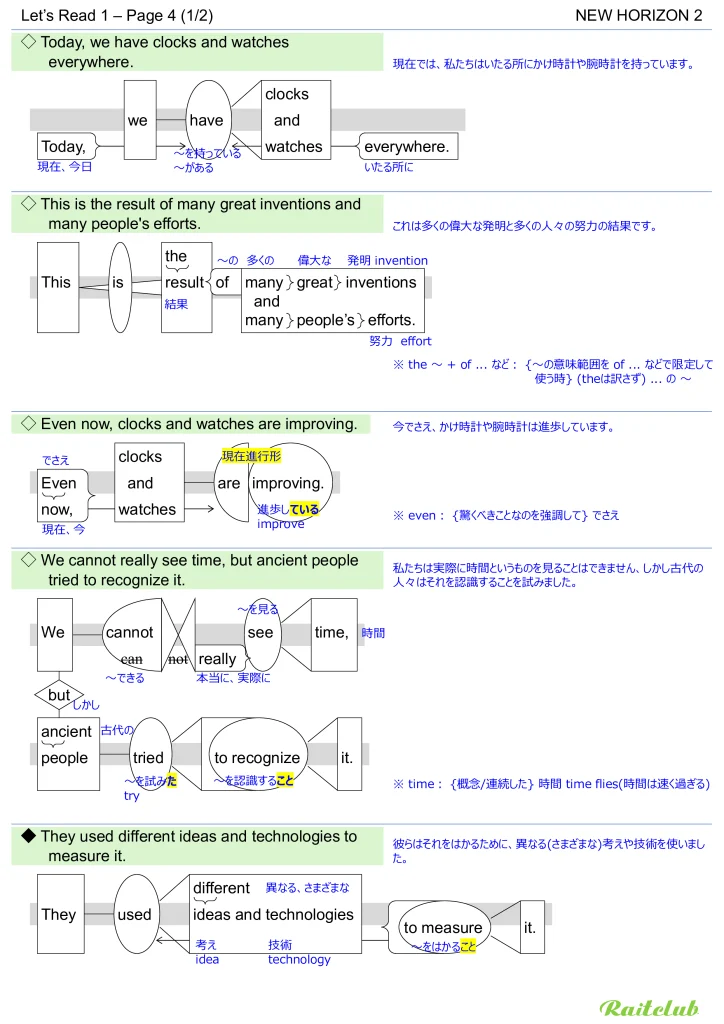
英文見える化チャート 2/2
